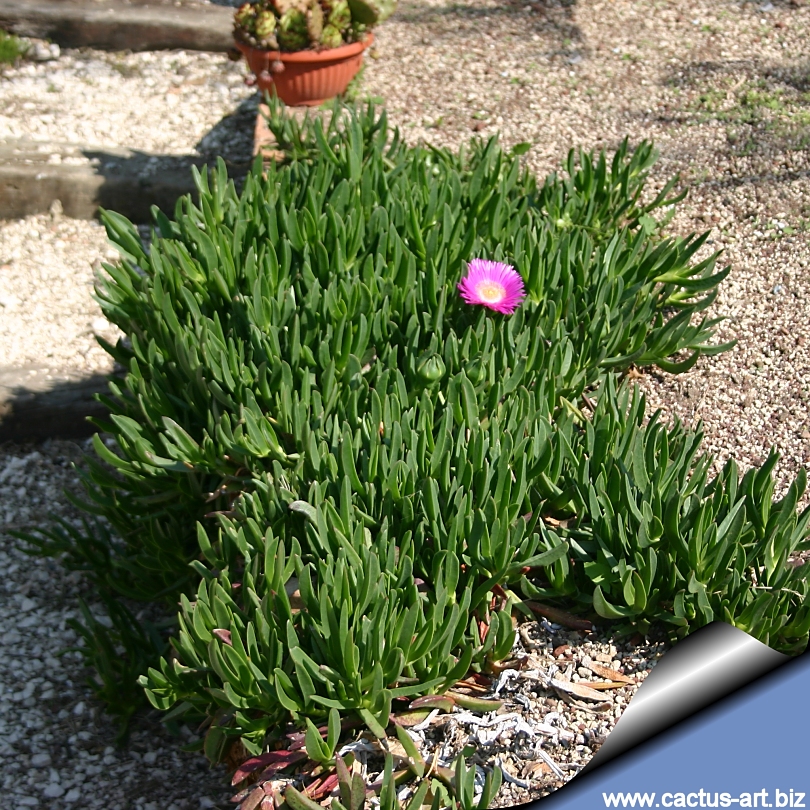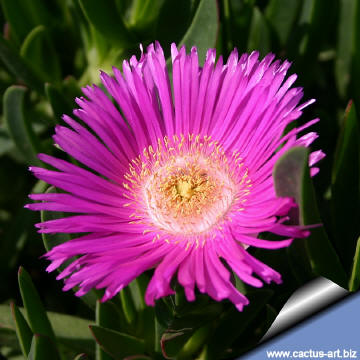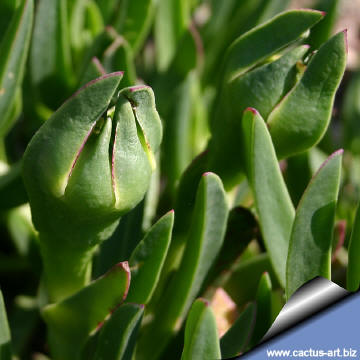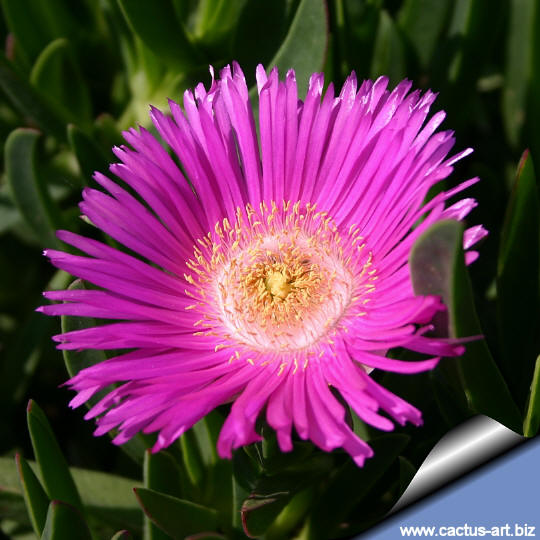|
|
|

Carpobrotus
acinaciformis
The large pink flowers are very
showy and the plant is frequently cultivated. In many areas it has
become naturalised on sea cliffs and shores.
|
 |
 |
|
. |

|

|
|
USE
-
It
is an easy-to-grow
groundcover, ideal for low-maintenance and water-wise gardens.
- Its leaves are edible, as
are its fruit, as with other some members of the Aizoaceae family. In
South Africa the Sour Fig's ripe fruit are gathered and either eaten
fresh or made into a very tart jam. The fruits are tasty and can
be eaten fresh.
|
|


Advertising
|
|
|
|
|
Family: Mesebrianthemaceae (Aizoaceae)
Scientific name: Carpobrotus
acinaciformis
(L.) L.Bolus
Origin: The
species is native to South Africa but is naturalised in many other
regions throughout the world, notably Australia, California and the
Mediterranean, all of which share a similar climate.
Habitat:
It is particularly resistant to
some harsh coastal climatic conditions and to salt where it may forms
large monospecific zones. But due to the fact that it easily spreads by
seed and from segmentation (any shoot segment can produce roots) it has
escaped from cultivation and has become an invasive species. It is now
common along highways, beaches and in other landscapes. (
loose sands, dune, dune scrub, coastal
scrub, coastal prairie and rocky outcrops).
Now parts of the coastline of many countries in mild climate areas are
completely covered by this invasive plant that compete
with native species.
Conservation status: Listed in
CITES appendix 2.
Common Names include: Ice Plant, Highway Ice Plant,
Pigface or Hottentot Fig and in South Africa as the Sour Fig, on account
of its edible fruit.
Etymology:
acinaciformis
= scimitar shaped
|
|
Description: Carpobrotus acinaciformis is a robust and fast
growing creeping, mat-forming succulent that grow year round, with
individual shoot segments growing more than 1 m per year.
Stems: Flat-growing, trailing and curved upwards at the growing
point. The stems root at nodes and are up to 2 m long (or more).
Leaves: Succulent, crowded along the stem, opposite,
thick 60-130 x 10-17 mm,
sabre-shaped, sharply 3-angled and
triangular in cross-section, curved upward,
yellowish to grass-green, often tinged red along edge. Adaxial and
lateral surfaces distinctly concave; keel denticulate, sometimes only in
upper portion. Foliage can turn a vibrant red to yellow in colour when
older.
Flowers: Solitary
at the end of a short stalk,
hermaphrodite (have both male and female organs)10-15 cm in diameter,
daisy-like with many stamens (400-600) surrounding a starfish-like
stigma. The colour vary from
brilliant pink-violet to
dark magenta (white flowering cultivars are reported too). Calyx oblong
or nearly globose; petals rose- or purplish-pink; top of the ovary flat
or slightly concave They open in the morning in bright sunlight, close
at night, and are pollinated by Bees.
Blooming season: Flowering occurs almost year round (depending on
climate and clone) but mainly in spring and summer. (May to July)
Fruit: Fleshy,
constricted at the base, indehiscent, 35 mm in diameter,
shaped like a spinning top, on a winged stalk The fruit is edible yellow
and fragrant when ripe. The outer wall of the fruit becomes yellowish,
wrinkled and leathery with age.
Seeds: The seeds are embedded in the sticky, sweet, jelly-like
mucilage. Seed production is high, with hundreds of seeds produced in
each fruit., and ripen from August to September.
|
|
|
|

The flower is solitary
at the end of a short stalk,
hermaphrodite (have both male and female organs) and is very large and
showy, up 10-15 cm in diameter,
with many stamens (400-600) surrounding a starfish-like stigma.
Note: There are several species
of this South African genus of succulents many of them so similar that
many may be hybrids.
Cultivation: The plants in this genus
represent some of the more easily cultivated succulent species.
Water moderately from early spring to
the end of autumn, and keep the compost quite dry when the plants are
dormant watering, only if the plant starts
shrivelling (, but they will generally grow even in winter if given
water) In areas prone to frost, grow in an intermediate greenhouse or
conservatory, in pots of cactus compost, obtainable from good garden
centres. Provide maximum light all the year round.
Propagation: Seeds or cuttings. Seeds
can be sown in early to mid-spring and germinated in heated humid
environment. Alternatively, use stem cuttings taken towards the end of
summer.
|
|